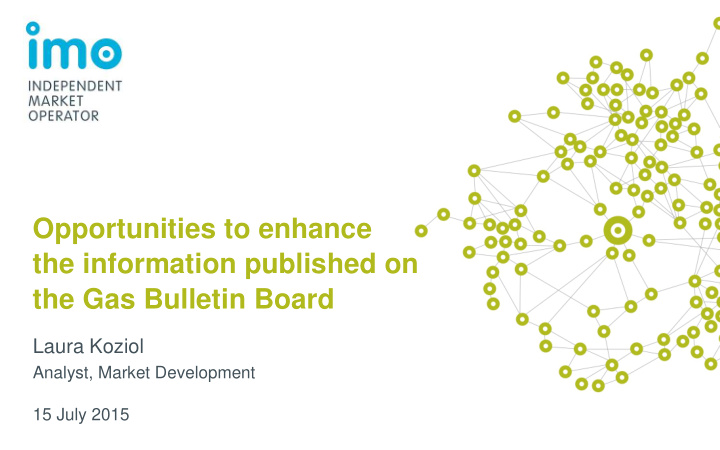



Opportunities to enhance the information published on the Gas Bulletin Board Laura Koziol Analyst, Market Development 15 July 2015
Background At the May 2015 GAB meeting further discussion on the opportunities to enhance the provision of information on the GBB was requested. The IMO plans to progressively make data more user friendly by developing and publishing ‘visualisations’ of information from the GBB that it considers is important and/or useful for stakeholders. This presentation provides examples for visualisations of: • Information currently published • Information currently collected by the IMO but published in aggregated for or with a time lag • Information currently not collected 2
Data currently available on the GBB Data published as collected • Nameplate Capacity per Facility • Capacity Outlook per Facility • Linepack Capacity Adequacy (LCA) per Facility • Medium Term Capacity Outlook per Facility • Gas Specification Data per Facility Data variations published • Daily Actual Consumption 5 days time lag Data per Facility • Daily Actual Flow Data per Delivery and Receipt Point aggregated by Zone • Nominated and Forecast Flow Data per Delivery and Receipt Point 3
Current GBB data publication - example 4
GBB data presentation opportunities - examples • Daily Actual Flow data per Production Facility • Large User Consumption data received and received and published with a time lag of 2 Gas published with a time lag of 7 Gas Days Days - currently published in list form - currently published in list form - could be published as graphic - could be published as graphic Note: these are mock Facilities with fictional data 5
Comparison of time periods as per WEM - example WEM Generation data Source: http://www.imowa.com.au/#weekly-numbers-generation • WEM Generation data shows an aggregated SWIS load profile, overlayed against comparable weeks, as chosen at the user’s discretion • A similar comparison could be implemented for the GBB using the Daily Actual Flow/Daily Actual Consumption Data, although over a longer time period 6
Changing the current treatment of information Reducing the time lag of publication to increase timeliness • Large User Consumption – currently 5 day time lag • Large User Consumption by Category – currently 5 day time lag Increasing the granularity of information • Nominated and Forecast Flow Data by Facility – currently aggregated by Zone • Daily Actual Consumption Data by Facility – currently 5 day time lag and aggregated by Zone 7
Nominated flow data per Facility - example • Currently available to the IMO per Delivery/Receipt Point published aggregated by Zone • Mock Graphs illustrate on a per Facility basis: - Nameplate Capacity - Nominated Flow Data - Medium Term Capacity Outlook and Capacity Outlook (for Production Facilities) Note: these are mock Facilities with fictional data 8
Opportunities to collect and publish additional information Examples include: • Supply disruption information – introduce an outage sign and information box, as in example • Information related to Westplan – alerts and related information • New categories or subcategories of users – Outage Advisory No. 123 12:30 PM for example LNG or CNG production APA advises that Parmelia Pipeline has an unplanned outage. Supply disruptions are not expected. Further updates on the outage will be posted when available. O 9
Recommend
More recommend